Criminal Procedure (Scotland) Act 1955: Evidence Law Case Analysis
VerifiedAdded on 2021/04/21
|19
|4872
|395
Report
AI Summary
This report provides a detailed analysis of an evidence law case involving Tony Arnott and Peter Dunn, focusing on the Criminal Procedure (Scotland) Act 1955. The report, prepared by a Junior Advocate Depute, examines the facts of the case, including the charges against the accused and the relevant legal provisions. It delves into the specifics of defense statements, admissible evidence, and exceptions to hearsay rules, as outlined in the Act. The analysis covers various types of evidence, such as documentary, real, and oral, as well as the roles of expert testimony and witness statements. The report also addresses the concept of corroboration, the plea of "no case to answer," and plea-bargaining. The document explores the admissibility of evidence, including the significance of key pieces of evidence like the locker and statements made by witnesses. It also examines specific legal precedents and the application of Scottish criminal law principles.
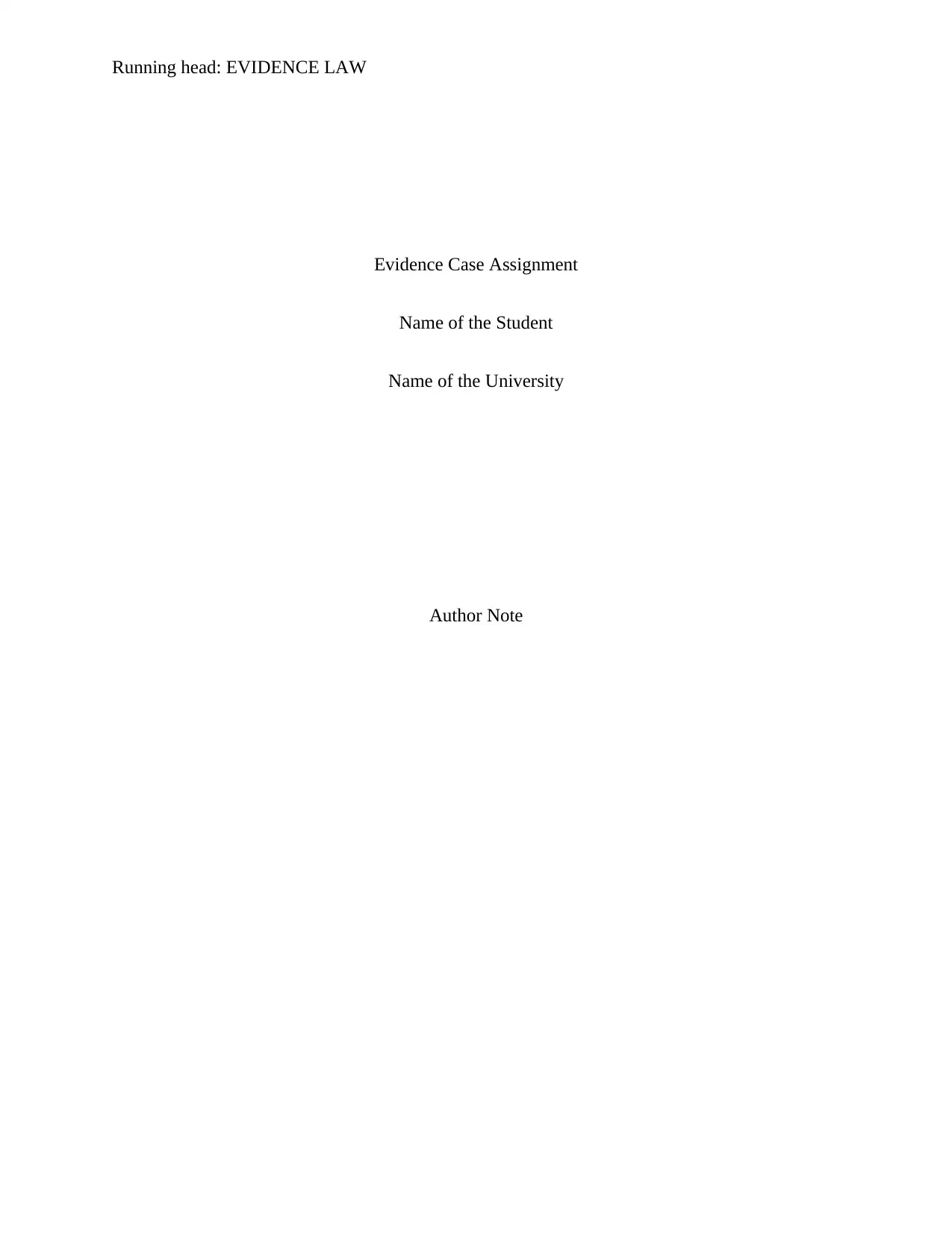
Running head: EVIDENCE LAW
Evidence Case Assignment
Name of the Student
Name of the University
Author Note
Evidence Case Assignment
Name of the Student
Name of the University
Author Note
Paraphrase This Document
Need a fresh take? Get an instant paraphrase of this document with our AI Paraphraser
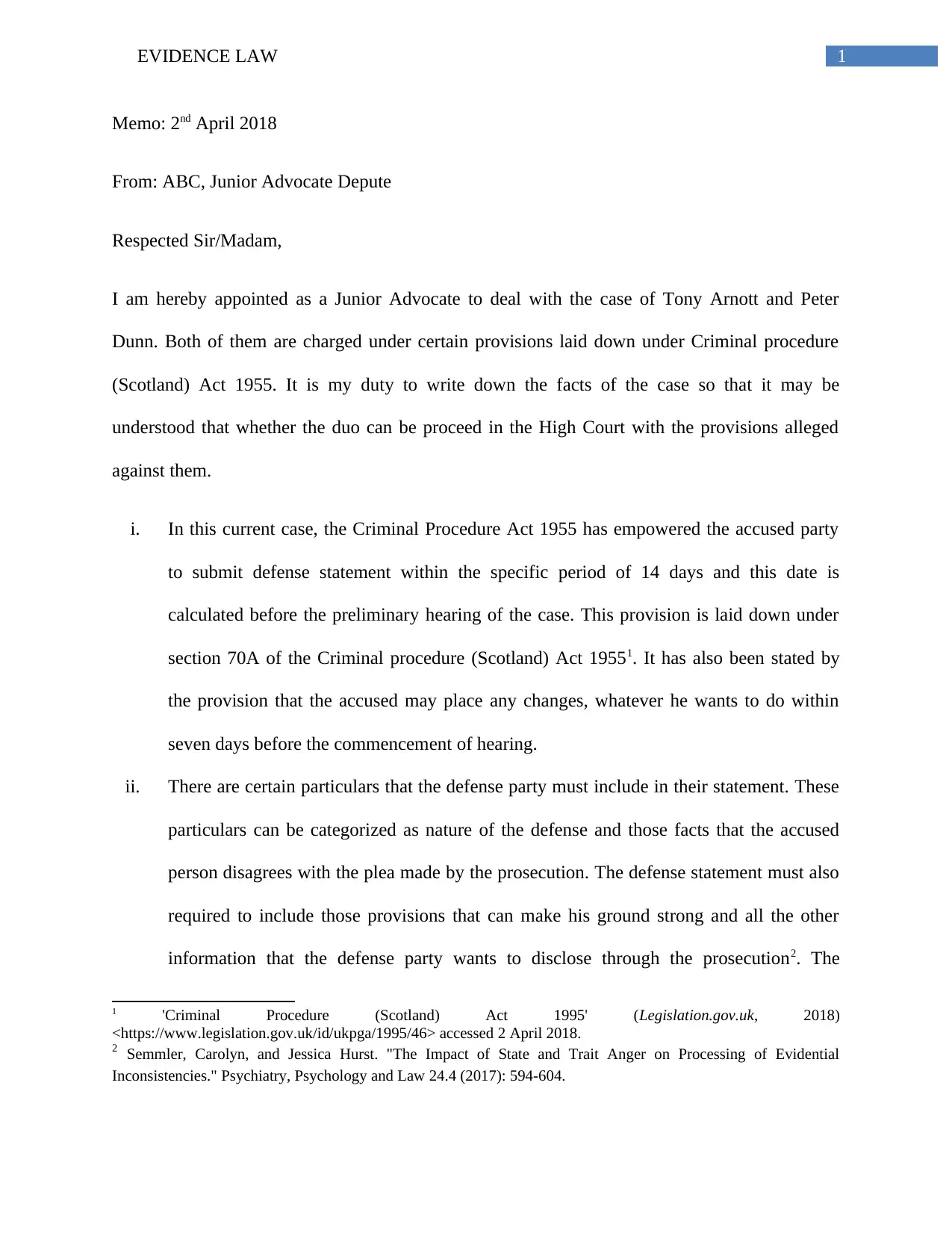
1EVIDENCE LAW
Memo: 2nd April 2018
From: ABC, Junior Advocate Depute
Respected Sir/Madam,
I am hereby appointed as a Junior Advocate to deal with the case of Tony Arnott and Peter
Dunn. Both of them are charged under certain provisions laid down under Criminal procedure
(Scotland) Act 1955. It is my duty to write down the facts of the case so that it may be
understood that whether the duo can be proceed in the High Court with the provisions alleged
against them.
i. In this current case, the Criminal Procedure Act 1955 has empowered the accused party
to submit defense statement within the specific period of 14 days and this date is
calculated before the preliminary hearing of the case. This provision is laid down under
section 70A of the Criminal procedure (Scotland) Act 19551. It has also been stated by
the provision that the accused may place any changes, whatever he wants to do within
seven days before the commencement of hearing.
ii. There are certain particulars that the defense party must include in their statement. These
particulars can be categorized as nature of the defense and those facts that the accused
person disagrees with the plea made by the prosecution. The defense statement must also
required to include those provisions that can make his ground strong and all the other
information that the defense party wants to disclose through the prosecution2. The
1 'Criminal Procedure (Scotland) Act 1995' (Legislation.gov.uk, 2018)
<https://www.legislation.gov.uk/id/ukpga/1995/46> accessed 2 April 2018.
2 Semmler, Carolyn, and Jessica Hurst. "The Impact of State and Trait Anger on Processing of Evidential
Inconsistencies." Psychiatry, Psychology and Law 24.4 (2017): 594-604.
Memo: 2nd April 2018
From: ABC, Junior Advocate Depute
Respected Sir/Madam,
I am hereby appointed as a Junior Advocate to deal with the case of Tony Arnott and Peter
Dunn. Both of them are charged under certain provisions laid down under Criminal procedure
(Scotland) Act 1955. It is my duty to write down the facts of the case so that it may be
understood that whether the duo can be proceed in the High Court with the provisions alleged
against them.
i. In this current case, the Criminal Procedure Act 1955 has empowered the accused party
to submit defense statement within the specific period of 14 days and this date is
calculated before the preliminary hearing of the case. This provision is laid down under
section 70A of the Criminal procedure (Scotland) Act 19551. It has also been stated by
the provision that the accused may place any changes, whatever he wants to do within
seven days before the commencement of hearing.
ii. There are certain particulars that the defense party must include in their statement. These
particulars can be categorized as nature of the defense and those facts that the accused
person disagrees with the plea made by the prosecution. The defense statement must also
required to include those provisions that can make his ground strong and all the other
information that the defense party wants to disclose through the prosecution2. The
1 'Criminal Procedure (Scotland) Act 1995' (Legislation.gov.uk, 2018)
<https://www.legislation.gov.uk/id/ukpga/1995/46> accessed 2 April 2018.
2 Semmler, Carolyn, and Jessica Hurst. "The Impact of State and Trait Anger on Processing of Evidential
Inconsistencies." Psychiatry, Psychology and Law 24.4 (2017): 594-604.
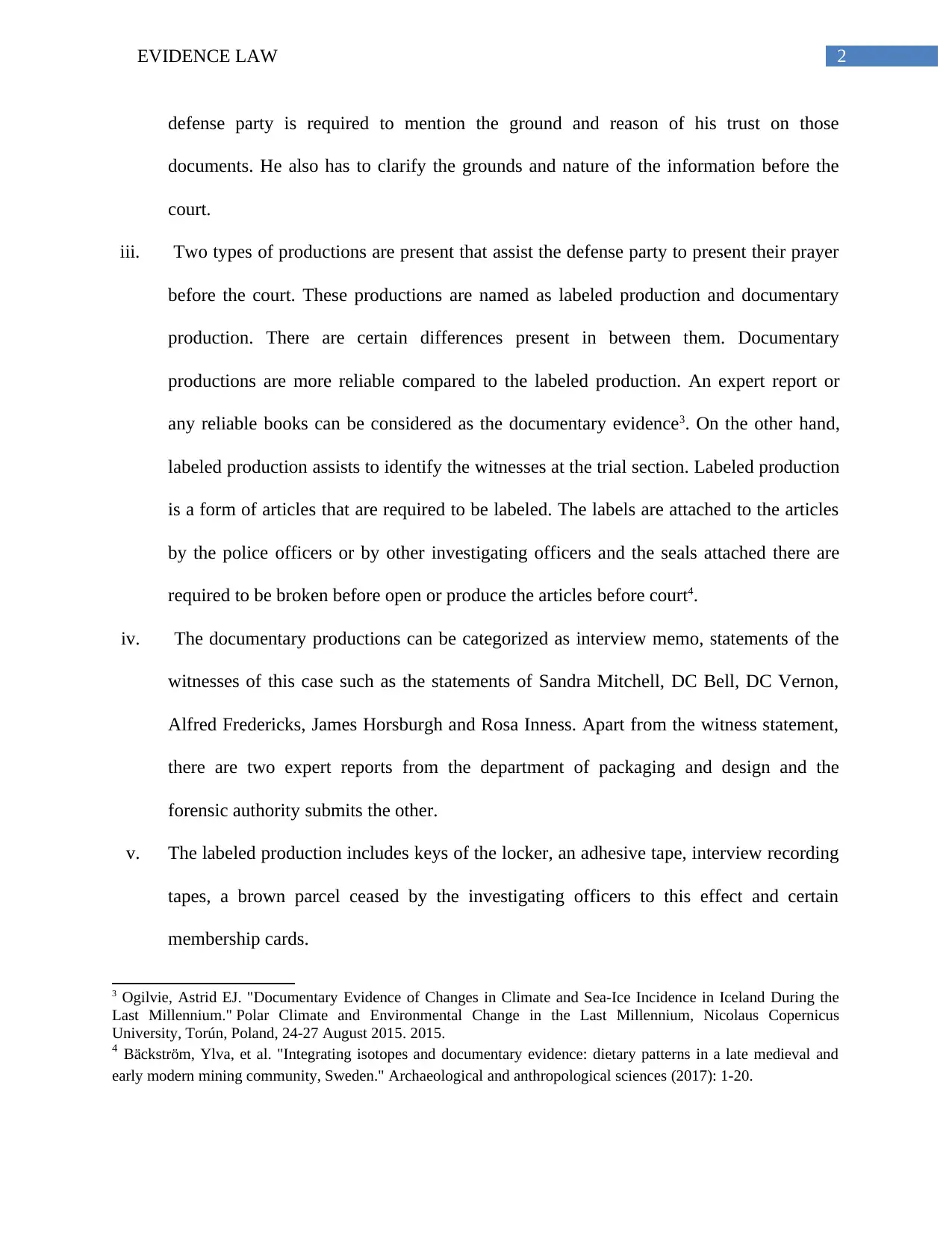
2EVIDENCE LAW
defense party is required to mention the ground and reason of his trust on those
documents. He also has to clarify the grounds and nature of the information before the
court.
iii. Two types of productions are present that assist the defense party to present their prayer
before the court. These productions are named as labeled production and documentary
production. There are certain differences present in between them. Documentary
productions are more reliable compared to the labeled production. An expert report or
any reliable books can be considered as the documentary evidence3. On the other hand,
labeled production assists to identify the witnesses at the trial section. Labeled production
is a form of articles that are required to be labeled. The labels are attached to the articles
by the police officers or by other investigating officers and the seals attached there are
required to be broken before open or produce the articles before court4.
iv. The documentary productions can be categorized as interview memo, statements of the
witnesses of this case such as the statements of Sandra Mitchell, DC Bell, DC Vernon,
Alfred Fredericks, James Horsburgh and Rosa Inness. Apart from the witness statement,
there are two expert reports from the department of packaging and design and the
forensic authority submits the other.
v. The labeled production includes keys of the locker, an adhesive tape, interview recording
tapes, a brown parcel ceased by the investigating officers to this effect and certain
membership cards.
3 Ogilvie, Astrid EJ. "Documentary Evidence of Changes in Climate and Sea-Ice Incidence in Iceland During the
Last Millennium." Polar Climate and Environmental Change in the Last Millennium, Nicolaus Copernicus
University, Torún, Poland, 24-27 August 2015. 2015.
4 Bäckström, Ylva, et al. "Integrating isotopes and documentary evidence: dietary patterns in a late medieval and
early modern mining community, Sweden." Archaeological and anthropological sciences (2017): 1-20.
defense party is required to mention the ground and reason of his trust on those
documents. He also has to clarify the grounds and nature of the information before the
court.
iii. Two types of productions are present that assist the defense party to present their prayer
before the court. These productions are named as labeled production and documentary
production. There are certain differences present in between them. Documentary
productions are more reliable compared to the labeled production. An expert report or
any reliable books can be considered as the documentary evidence3. On the other hand,
labeled production assists to identify the witnesses at the trial section. Labeled production
is a form of articles that are required to be labeled. The labels are attached to the articles
by the police officers or by other investigating officers and the seals attached there are
required to be broken before open or produce the articles before court4.
iv. The documentary productions can be categorized as interview memo, statements of the
witnesses of this case such as the statements of Sandra Mitchell, DC Bell, DC Vernon,
Alfred Fredericks, James Horsburgh and Rosa Inness. Apart from the witness statement,
there are two expert reports from the department of packaging and design and the
forensic authority submits the other.
v. The labeled production includes keys of the locker, an adhesive tape, interview recording
tapes, a brown parcel ceased by the investigating officers to this effect and certain
membership cards.
3 Ogilvie, Astrid EJ. "Documentary Evidence of Changes in Climate and Sea-Ice Incidence in Iceland During the
Last Millennium." Polar Climate and Environmental Change in the Last Millennium, Nicolaus Copernicus
University, Torún, Poland, 24-27 August 2015. 2015.
4 Bäckström, Ylva, et al. "Integrating isotopes and documentary evidence: dietary patterns in a late medieval and
early modern mining community, Sweden." Archaeological and anthropological sciences (2017): 1-20.
⊘ This is a preview!⊘
Do you want full access?
Subscribe today to unlock all pages.

Trusted by 1+ million students worldwide
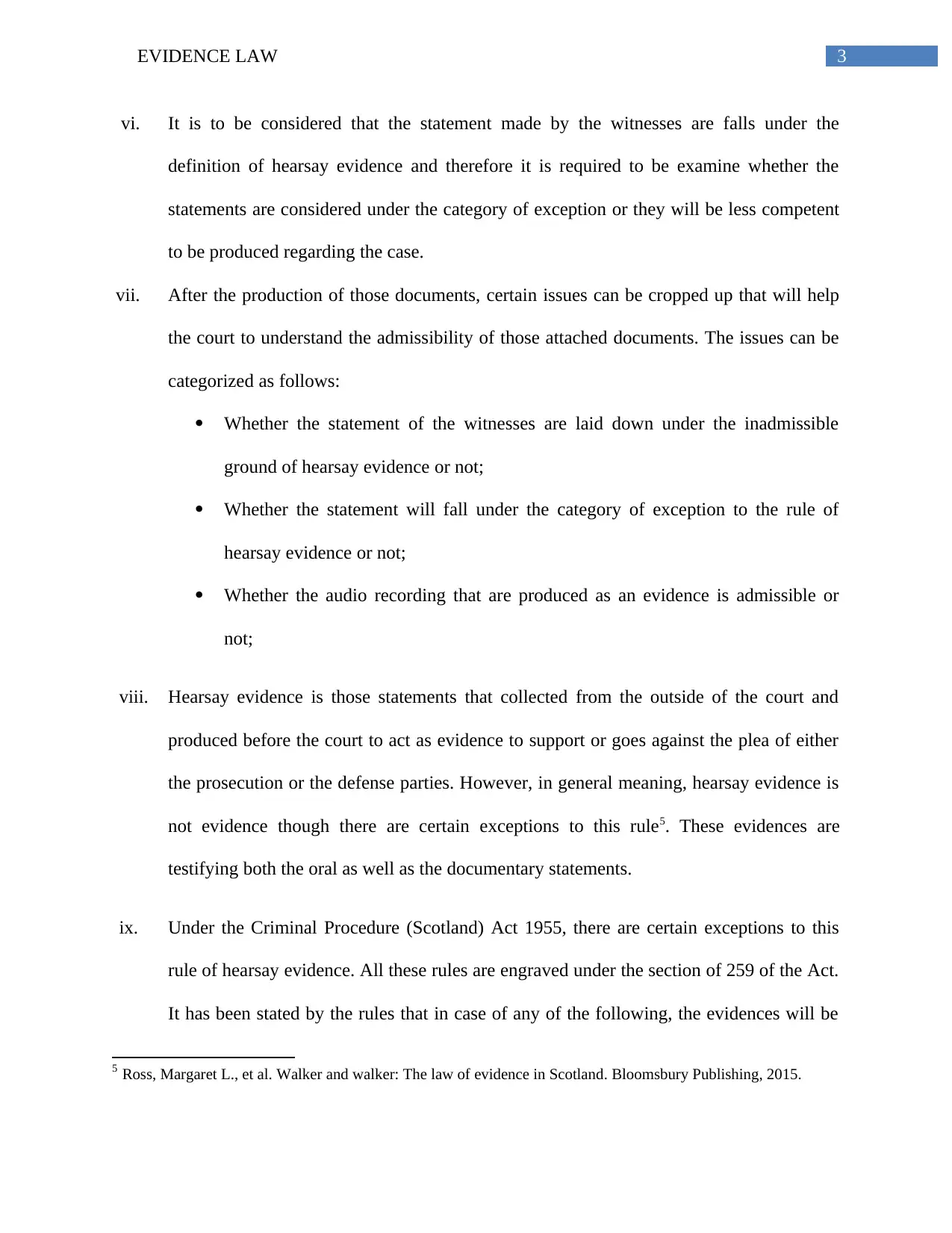
3EVIDENCE LAW
vi. It is to be considered that the statement made by the witnesses are falls under the
definition of hearsay evidence and therefore it is required to be examine whether the
statements are considered under the category of exception or they will be less competent
to be produced regarding the case.
vii. After the production of those documents, certain issues can be cropped up that will help
the court to understand the admissibility of those attached documents. The issues can be
categorized as follows:
Whether the statement of the witnesses are laid down under the inadmissible
ground of hearsay evidence or not;
Whether the statement will fall under the category of exception to the rule of
hearsay evidence or not;
Whether the audio recording that are produced as an evidence is admissible or
not;
viii. Hearsay evidence is those statements that collected from the outside of the court and
produced before the court to act as evidence to support or goes against the plea of either
the prosecution or the defense parties. However, in general meaning, hearsay evidence is
not evidence though there are certain exceptions to this rule5. These evidences are
testifying both the oral as well as the documentary statements.
ix. Under the Criminal Procedure (Scotland) Act 1955, there are certain exceptions to this
rule of hearsay evidence. All these rules are engraved under the section of 259 of the Act.
It has been stated by the rules that in case of any of the following, the evidences will be
5 Ross, Margaret L., et al. Walker and walker: The law of evidence in Scotland. Bloomsbury Publishing, 2015.
vi. It is to be considered that the statement made by the witnesses are falls under the
definition of hearsay evidence and therefore it is required to be examine whether the
statements are considered under the category of exception or they will be less competent
to be produced regarding the case.
vii. After the production of those documents, certain issues can be cropped up that will help
the court to understand the admissibility of those attached documents. The issues can be
categorized as follows:
Whether the statement of the witnesses are laid down under the inadmissible
ground of hearsay evidence or not;
Whether the statement will fall under the category of exception to the rule of
hearsay evidence or not;
Whether the audio recording that are produced as an evidence is admissible or
not;
viii. Hearsay evidence is those statements that collected from the outside of the court and
produced before the court to act as evidence to support or goes against the plea of either
the prosecution or the defense parties. However, in general meaning, hearsay evidence is
not evidence though there are certain exceptions to this rule5. These evidences are
testifying both the oral as well as the documentary statements.
ix. Under the Criminal Procedure (Scotland) Act 1955, there are certain exceptions to this
rule of hearsay evidence. All these rules are engraved under the section of 259 of the Act.
It has been stated by the rules that in case of any of the following, the evidences will be
5 Ross, Margaret L., et al. Walker and walker: The law of evidence in Scotland. Bloomsbury Publishing, 2015.
Paraphrase This Document
Need a fresh take? Get an instant paraphrase of this document with our AI Paraphraser
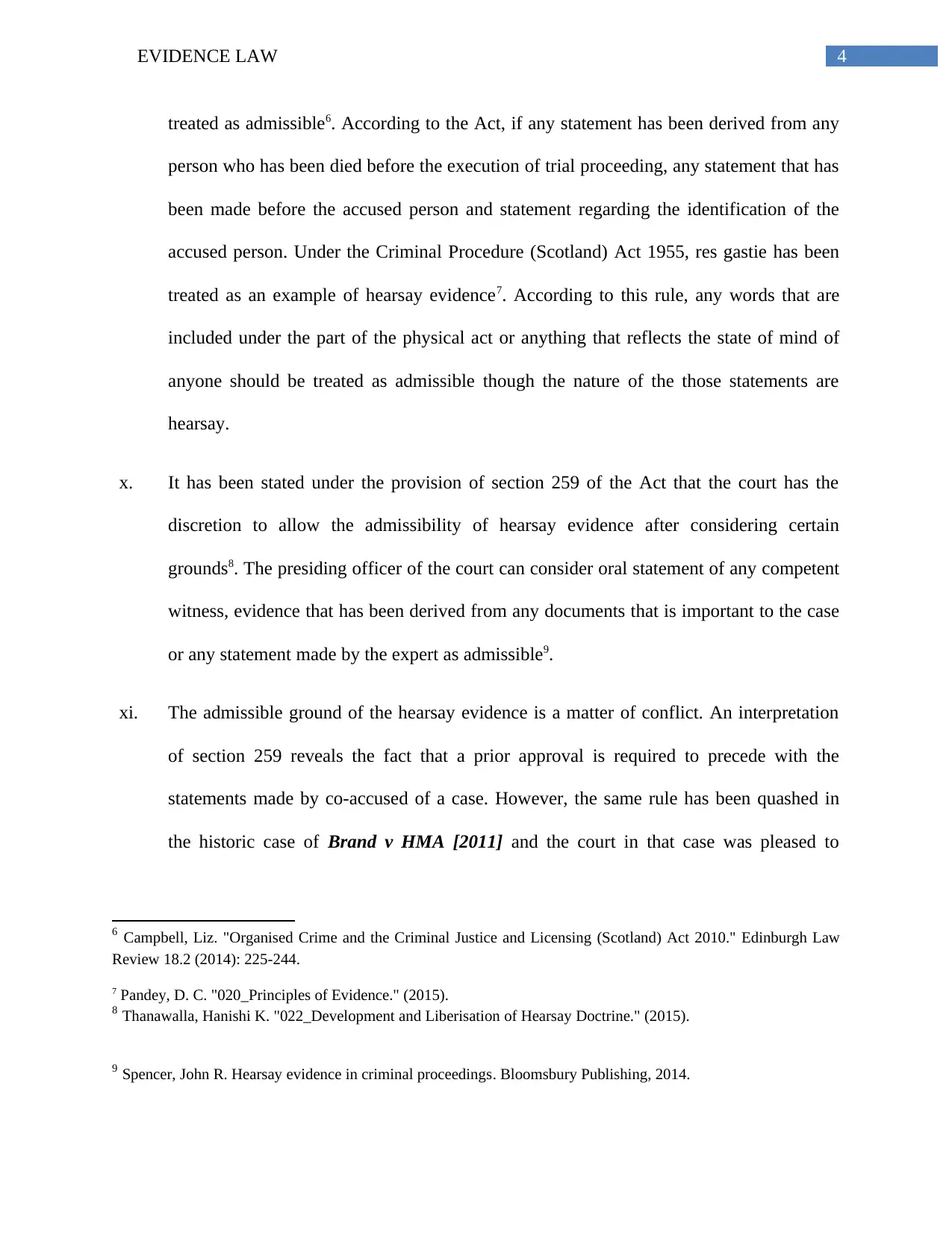
4EVIDENCE LAW
treated as admissible6. According to the Act, if any statement has been derived from any
person who has been died before the execution of trial proceeding, any statement that has
been made before the accused person and statement regarding the identification of the
accused person. Under the Criminal Procedure (Scotland) Act 1955, res gastie has been
treated as an example of hearsay evidence7. According to this rule, any words that are
included under the part of the physical act or anything that reflects the state of mind of
anyone should be treated as admissible though the nature of the those statements are
hearsay.
x. It has been stated under the provision of section 259 of the Act that the court has the
discretion to allow the admissibility of hearsay evidence after considering certain
grounds8. The presiding officer of the court can consider oral statement of any competent
witness, evidence that has been derived from any documents that is important to the case
or any statement made by the expert as admissible9.
xi. The admissible ground of the hearsay evidence is a matter of conflict. An interpretation
of section 259 reveals the fact that a prior approval is required to precede with the
statements made by co-accused of a case. However, the same rule has been quashed in
the historic case of Brand v HMA [2011] and the court in that case was pleased to
6 Campbell, Liz. "Organised Crime and the Criminal Justice and Licensing (Scotland) Act 2010." Edinburgh Law
Review 18.2 (2014): 225-244.
7 Pandey, D. C. "020_Principles of Evidence." (2015).
8 Thanawalla, Hanishi K. "022_Development and Liberisation of Hearsay Doctrine." (2015).
9 Spencer, John R. Hearsay evidence in criminal proceedings. Bloomsbury Publishing, 2014.
treated as admissible6. According to the Act, if any statement has been derived from any
person who has been died before the execution of trial proceeding, any statement that has
been made before the accused person and statement regarding the identification of the
accused person. Under the Criminal Procedure (Scotland) Act 1955, res gastie has been
treated as an example of hearsay evidence7. According to this rule, any words that are
included under the part of the physical act or anything that reflects the state of mind of
anyone should be treated as admissible though the nature of the those statements are
hearsay.
x. It has been stated under the provision of section 259 of the Act that the court has the
discretion to allow the admissibility of hearsay evidence after considering certain
grounds8. The presiding officer of the court can consider oral statement of any competent
witness, evidence that has been derived from any documents that is important to the case
or any statement made by the expert as admissible9.
xi. The admissible ground of the hearsay evidence is a matter of conflict. An interpretation
of section 259 reveals the fact that a prior approval is required to precede with the
statements made by co-accused of a case. However, the same rule has been quashed in
the historic case of Brand v HMA [2011] and the court in that case was pleased to
6 Campbell, Liz. "Organised Crime and the Criminal Justice and Licensing (Scotland) Act 2010." Edinburgh Law
Review 18.2 (2014): 225-244.
7 Pandey, D. C. "020_Principles of Evidence." (2015).
8 Thanawalla, Hanishi K. "022_Development and Liberisation of Hearsay Doctrine." (2015).
9 Spencer, John R. Hearsay evidence in criminal proceedings. Bloomsbury Publishing, 2014.
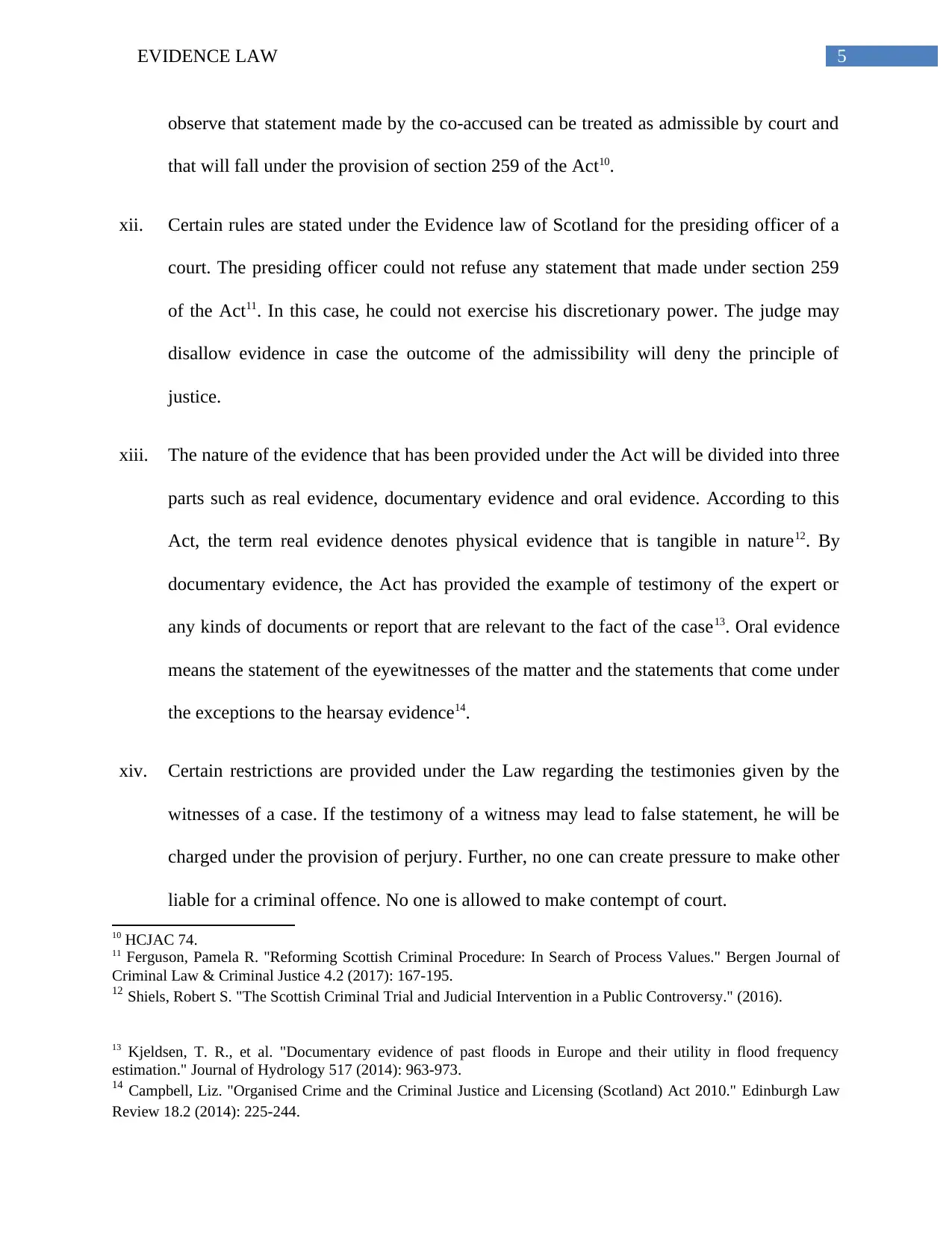
5EVIDENCE LAW
observe that statement made by the co-accused can be treated as admissible by court and
that will fall under the provision of section 259 of the Act10.
xii. Certain rules are stated under the Evidence law of Scotland for the presiding officer of a
court. The presiding officer could not refuse any statement that made under section 259
of the Act11. In this case, he could not exercise his discretionary power. The judge may
disallow evidence in case the outcome of the admissibility will deny the principle of
justice.
xiii. The nature of the evidence that has been provided under the Act will be divided into three
parts such as real evidence, documentary evidence and oral evidence. According to this
Act, the term real evidence denotes physical evidence that is tangible in nature12. By
documentary evidence, the Act has provided the example of testimony of the expert or
any kinds of documents or report that are relevant to the fact of the case13. Oral evidence
means the statement of the eyewitnesses of the matter and the statements that come under
the exceptions to the hearsay evidence14.
xiv. Certain restrictions are provided under the Law regarding the testimonies given by the
witnesses of a case. If the testimony of a witness may lead to false statement, he will be
charged under the provision of perjury. Further, no one can create pressure to make other
liable for a criminal offence. No one is allowed to make contempt of court.
10 HCJAC 74.
11 Ferguson, Pamela R. "Reforming Scottish Criminal Procedure: In Search of Process Values." Bergen Journal of
Criminal Law & Criminal Justice 4.2 (2017): 167-195.
12 Shiels, Robert S. "The Scottish Criminal Trial and Judicial Intervention in a Public Controversy." (2016).
13 Kjeldsen, T. R., et al. "Documentary evidence of past floods in Europe and their utility in flood frequency
estimation." Journal of Hydrology 517 (2014): 963-973.
14 Campbell, Liz. "Organised Crime and the Criminal Justice and Licensing (Scotland) Act 2010." Edinburgh Law
Review 18.2 (2014): 225-244.
observe that statement made by the co-accused can be treated as admissible by court and
that will fall under the provision of section 259 of the Act10.
xii. Certain rules are stated under the Evidence law of Scotland for the presiding officer of a
court. The presiding officer could not refuse any statement that made under section 259
of the Act11. In this case, he could not exercise his discretionary power. The judge may
disallow evidence in case the outcome of the admissibility will deny the principle of
justice.
xiii. The nature of the evidence that has been provided under the Act will be divided into three
parts such as real evidence, documentary evidence and oral evidence. According to this
Act, the term real evidence denotes physical evidence that is tangible in nature12. By
documentary evidence, the Act has provided the example of testimony of the expert or
any kinds of documents or report that are relevant to the fact of the case13. Oral evidence
means the statement of the eyewitnesses of the matter and the statements that come under
the exceptions to the hearsay evidence14.
xiv. Certain restrictions are provided under the Law regarding the testimonies given by the
witnesses of a case. If the testimony of a witness may lead to false statement, he will be
charged under the provision of perjury. Further, no one can create pressure to make other
liable for a criminal offence. No one is allowed to make contempt of court.
10 HCJAC 74.
11 Ferguson, Pamela R. "Reforming Scottish Criminal Procedure: In Search of Process Values." Bergen Journal of
Criminal Law & Criminal Justice 4.2 (2017): 167-195.
12 Shiels, Robert S. "The Scottish Criminal Trial and Judicial Intervention in a Public Controversy." (2016).
13 Kjeldsen, T. R., et al. "Documentary evidence of past floods in Europe and their utility in flood frequency
estimation." Journal of Hydrology 517 (2014): 963-973.
14 Campbell, Liz. "Organised Crime and the Criminal Justice and Licensing (Scotland) Act 2010." Edinburgh Law
Review 18.2 (2014): 225-244.
⊘ This is a preview!⊘
Do you want full access?
Subscribe today to unlock all pages.

Trusted by 1+ million students worldwide
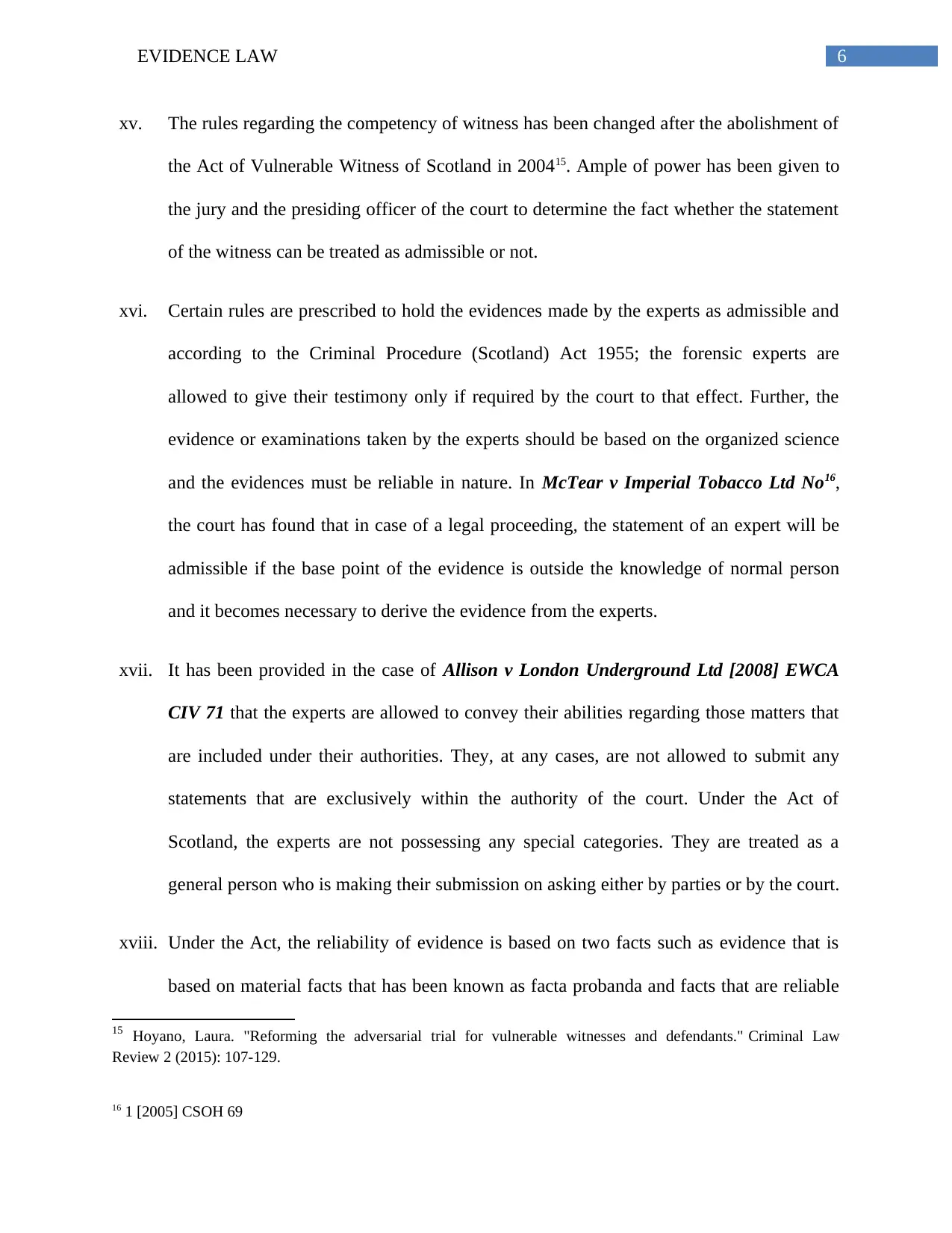
6EVIDENCE LAW
xv. The rules regarding the competency of witness has been changed after the abolishment of
the Act of Vulnerable Witness of Scotland in 200415. Ample of power has been given to
the jury and the presiding officer of the court to determine the fact whether the statement
of the witness can be treated as admissible or not.
xvi. Certain rules are prescribed to hold the evidences made by the experts as admissible and
according to the Criminal Procedure (Scotland) Act 1955; the forensic experts are
allowed to give their testimony only if required by the court to that effect. Further, the
evidence or examinations taken by the experts should be based on the organized science
and the evidences must be reliable in nature. In McTear v Imperial Tobacco Ltd No16,
the court has found that in case of a legal proceeding, the statement of an expert will be
admissible if the base point of the evidence is outside the knowledge of normal person
and it becomes necessary to derive the evidence from the experts.
xvii. It has been provided in the case of Allison v London Underground Ltd [2008] EWCA
CIV 71 that the experts are allowed to convey their abilities regarding those matters that
are included under their authorities. They, at any cases, are not allowed to submit any
statements that are exclusively within the authority of the court. Under the Act of
Scotland, the experts are not possessing any special categories. They are treated as a
general person who is making their submission on asking either by parties or by the court.
xviii. Under the Act, the reliability of evidence is based on two facts such as evidence that is
based on material facts that has been known as facta probanda and facts that are reliable
15 Hoyano, Laura. "Reforming the adversarial trial for vulnerable witnesses and defendants." Criminal Law
Review 2 (2015): 107-129.
16 1 [2005] CSOH 69
xv. The rules regarding the competency of witness has been changed after the abolishment of
the Act of Vulnerable Witness of Scotland in 200415. Ample of power has been given to
the jury and the presiding officer of the court to determine the fact whether the statement
of the witness can be treated as admissible or not.
xvi. Certain rules are prescribed to hold the evidences made by the experts as admissible and
according to the Criminal Procedure (Scotland) Act 1955; the forensic experts are
allowed to give their testimony only if required by the court to that effect. Further, the
evidence or examinations taken by the experts should be based on the organized science
and the evidences must be reliable in nature. In McTear v Imperial Tobacco Ltd No16,
the court has found that in case of a legal proceeding, the statement of an expert will be
admissible if the base point of the evidence is outside the knowledge of normal person
and it becomes necessary to derive the evidence from the experts.
xvii. It has been provided in the case of Allison v London Underground Ltd [2008] EWCA
CIV 71 that the experts are allowed to convey their abilities regarding those matters that
are included under their authorities. They, at any cases, are not allowed to submit any
statements that are exclusively within the authority of the court. Under the Act of
Scotland, the experts are not possessing any special categories. They are treated as a
general person who is making their submission on asking either by parties or by the court.
xviii. Under the Act, the reliability of evidence is based on two facts such as evidence that is
based on material facts that has been known as facta probanda and facts that are reliable
15 Hoyano, Laura. "Reforming the adversarial trial for vulnerable witnesses and defendants." Criminal Law
Review 2 (2015): 107-129.
16 1 [2005] CSOH 69
Paraphrase This Document
Need a fresh take? Get an instant paraphrase of this document with our AI Paraphraser
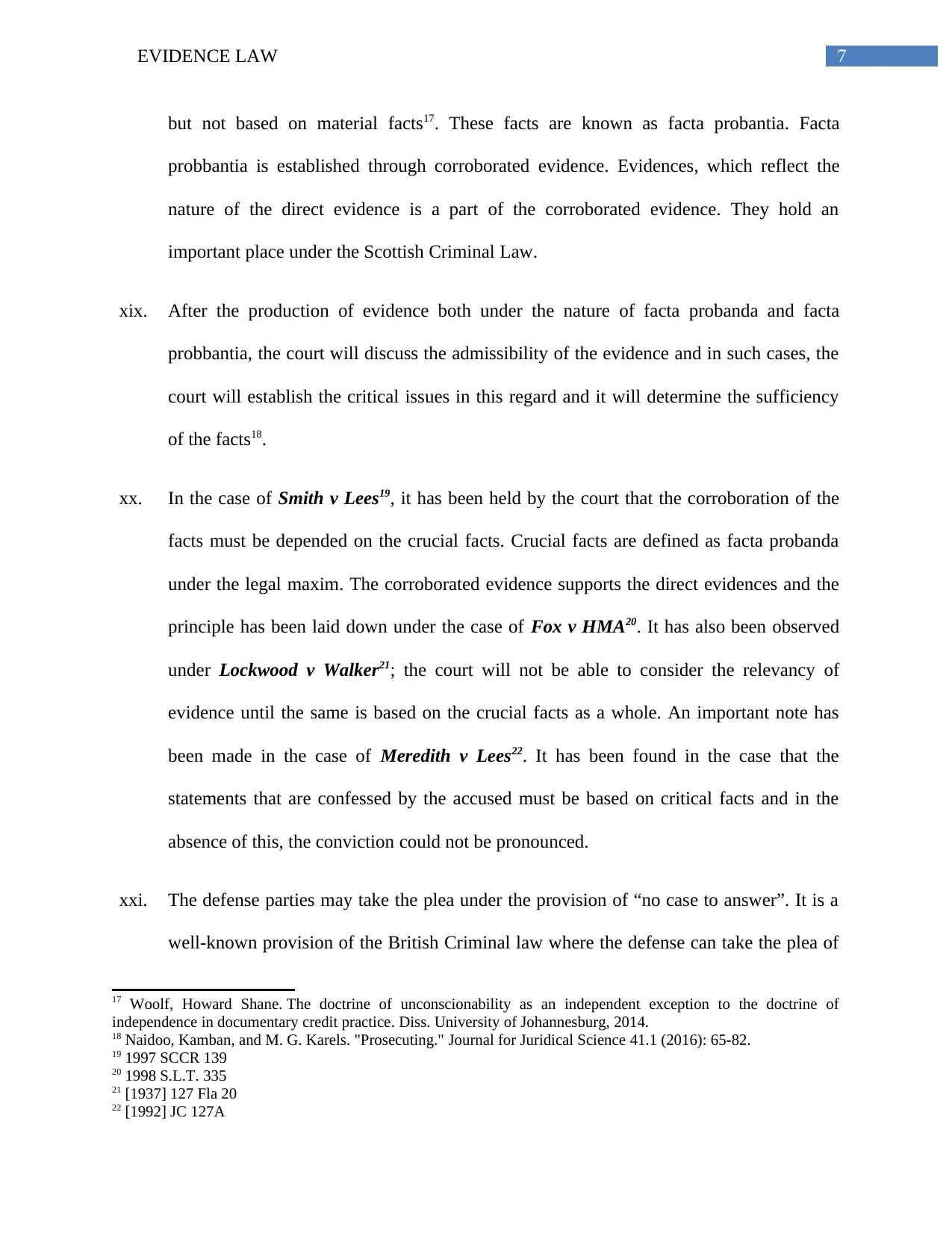
7EVIDENCE LAW
but not based on material facts17. These facts are known as facta probantia. Facta
probbantia is established through corroborated evidence. Evidences, which reflect the
nature of the direct evidence is a part of the corroborated evidence. They hold an
important place under the Scottish Criminal Law.
xix. After the production of evidence both under the nature of facta probanda and facta
probbantia, the court will discuss the admissibility of the evidence and in such cases, the
court will establish the critical issues in this regard and it will determine the sufficiency
of the facts18.
xx. In the case of Smith v Lees19, it has been held by the court that the corroboration of the
facts must be depended on the crucial facts. Crucial facts are defined as facta probanda
under the legal maxim. The corroborated evidence supports the direct evidences and the
principle has been laid down under the case of Fox v HMA20. It has also been observed
under Lockwood v Walker21; the court will not be able to consider the relevancy of
evidence until the same is based on the crucial facts as a whole. An important note has
been made in the case of Meredith v Lees22. It has been found in the case that the
statements that are confessed by the accused must be based on critical facts and in the
absence of this, the conviction could not be pronounced.
xxi. The defense parties may take the plea under the provision of “no case to answer”. It is a
well-known provision of the British Criminal law where the defense can take the plea of
17 Woolf, Howard Shane. The doctrine of unconscionability as an independent exception to the doctrine of
independence in documentary credit practice. Diss. University of Johannesburg, 2014.
18 Naidoo, Kamban, and M. G. Karels. "Prosecuting." Journal for Juridical Science 41.1 (2016): 65-82.
19 1997 SCCR 139
20 1998 S.L.T. 335
21 [1937] 127 Fla 20
22 [1992] JC 127A
but not based on material facts17. These facts are known as facta probantia. Facta
probbantia is established through corroborated evidence. Evidences, which reflect the
nature of the direct evidence is a part of the corroborated evidence. They hold an
important place under the Scottish Criminal Law.
xix. After the production of evidence both under the nature of facta probanda and facta
probbantia, the court will discuss the admissibility of the evidence and in such cases, the
court will establish the critical issues in this regard and it will determine the sufficiency
of the facts18.
xx. In the case of Smith v Lees19, it has been held by the court that the corroboration of the
facts must be depended on the crucial facts. Crucial facts are defined as facta probanda
under the legal maxim. The corroborated evidence supports the direct evidences and the
principle has been laid down under the case of Fox v HMA20. It has also been observed
under Lockwood v Walker21; the court will not be able to consider the relevancy of
evidence until the same is based on the crucial facts as a whole. An important note has
been made in the case of Meredith v Lees22. It has been found in the case that the
statements that are confessed by the accused must be based on critical facts and in the
absence of this, the conviction could not be pronounced.
xxi. The defense parties may take the plea under the provision of “no case to answer”. It is a
well-known provision of the British Criminal law where the defense can take the plea of
17 Woolf, Howard Shane. The doctrine of unconscionability as an independent exception to the doctrine of
independence in documentary credit practice. Diss. University of Johannesburg, 2014.
18 Naidoo, Kamban, and M. G. Karels. "Prosecuting." Journal for Juridical Science 41.1 (2016): 65-82.
19 1997 SCCR 139
20 1998 S.L.T. 335
21 [1937] 127 Fla 20
22 [1992] JC 127A
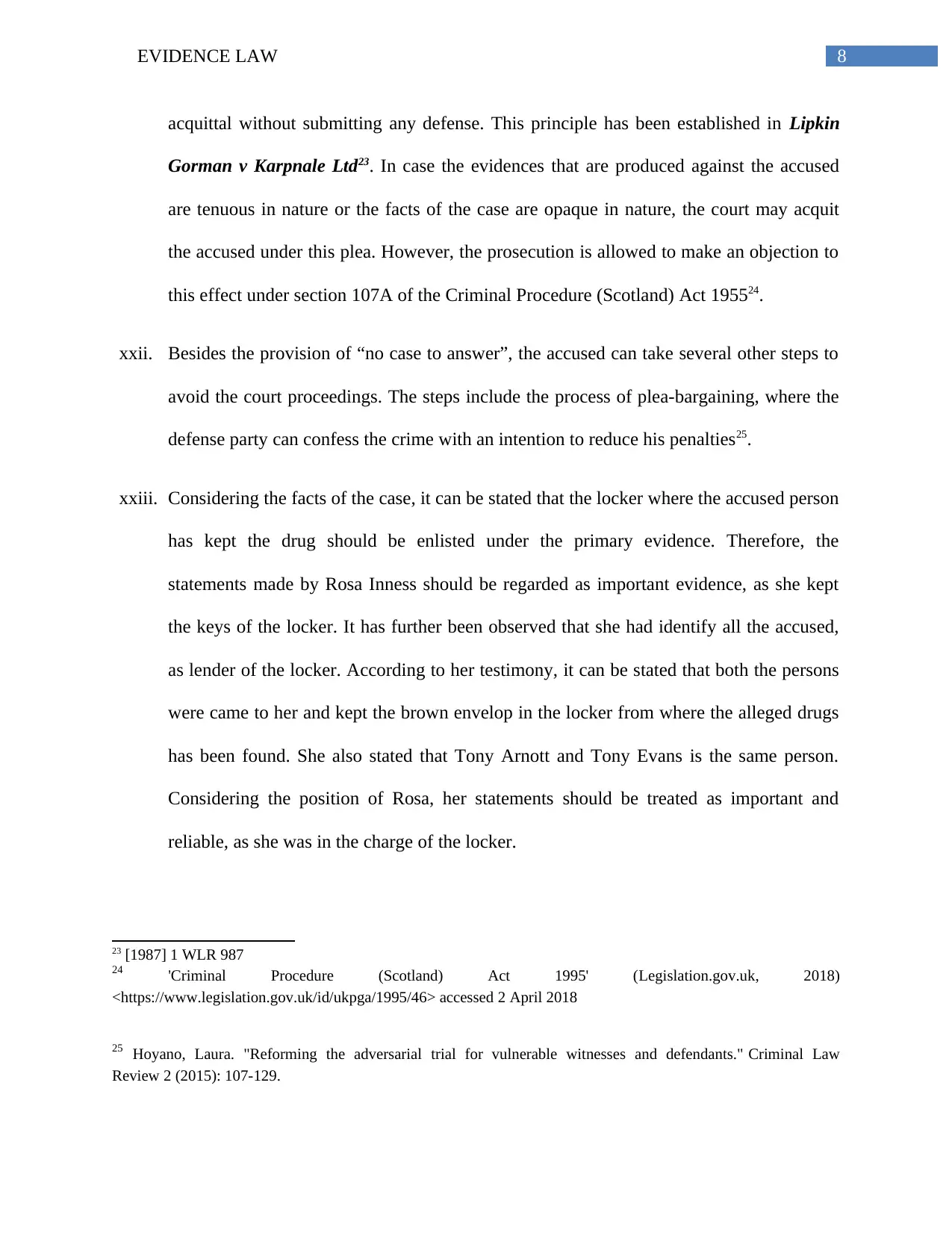
8EVIDENCE LAW
acquittal without submitting any defense. This principle has been established in Lipkin
Gorman v Karpnale Ltd23. In case the evidences that are produced against the accused
are tenuous in nature or the facts of the case are opaque in nature, the court may acquit
the accused under this plea. However, the prosecution is allowed to make an objection to
this effect under section 107A of the Criminal Procedure (Scotland) Act 195524.
xxii. Besides the provision of “no case to answer”, the accused can take several other steps to
avoid the court proceedings. The steps include the process of plea-bargaining, where the
defense party can confess the crime with an intention to reduce his penalties25.
xxiii. Considering the facts of the case, it can be stated that the locker where the accused person
has kept the drug should be enlisted under the primary evidence. Therefore, the
statements made by Rosa Inness should be regarded as important evidence, as she kept
the keys of the locker. It has further been observed that she had identify all the accused,
as lender of the locker. According to her testimony, it can be stated that both the persons
were came to her and kept the brown envelop in the locker from where the alleged drugs
has been found. She also stated that Tony Arnott and Tony Evans is the same person.
Considering the position of Rosa, her statements should be treated as important and
reliable, as she was in the charge of the locker.
23 [1987] 1 WLR 987
24 'Criminal Procedure (Scotland) Act 1995' (Legislation.gov.uk, 2018)
<https://www.legislation.gov.uk/id/ukpga/1995/46> accessed 2 April 2018
25 Hoyano, Laura. "Reforming the adversarial trial for vulnerable witnesses and defendants." Criminal Law
Review 2 (2015): 107-129.
acquittal without submitting any defense. This principle has been established in Lipkin
Gorman v Karpnale Ltd23. In case the evidences that are produced against the accused
are tenuous in nature or the facts of the case are opaque in nature, the court may acquit
the accused under this plea. However, the prosecution is allowed to make an objection to
this effect under section 107A of the Criminal Procedure (Scotland) Act 195524.
xxii. Besides the provision of “no case to answer”, the accused can take several other steps to
avoid the court proceedings. The steps include the process of plea-bargaining, where the
defense party can confess the crime with an intention to reduce his penalties25.
xxiii. Considering the facts of the case, it can be stated that the locker where the accused person
has kept the drug should be enlisted under the primary evidence. Therefore, the
statements made by Rosa Inness should be regarded as important evidence, as she kept
the keys of the locker. It has further been observed that she had identify all the accused,
as lender of the locker. According to her testimony, it can be stated that both the persons
were came to her and kept the brown envelop in the locker from where the alleged drugs
has been found. She also stated that Tony Arnott and Tony Evans is the same person.
Considering the position of Rosa, her statements should be treated as important and
reliable, as she was in the charge of the locker.
23 [1987] 1 WLR 987
24 'Criminal Procedure (Scotland) Act 1995' (Legislation.gov.uk, 2018)
<https://www.legislation.gov.uk/id/ukpga/1995/46> accessed 2 April 2018
25 Hoyano, Laura. "Reforming the adversarial trial for vulnerable witnesses and defendants." Criminal Law
Review 2 (2015): 107-129.
⊘ This is a preview!⊘
Do you want full access?
Subscribe today to unlock all pages.

Trusted by 1+ million students worldwide
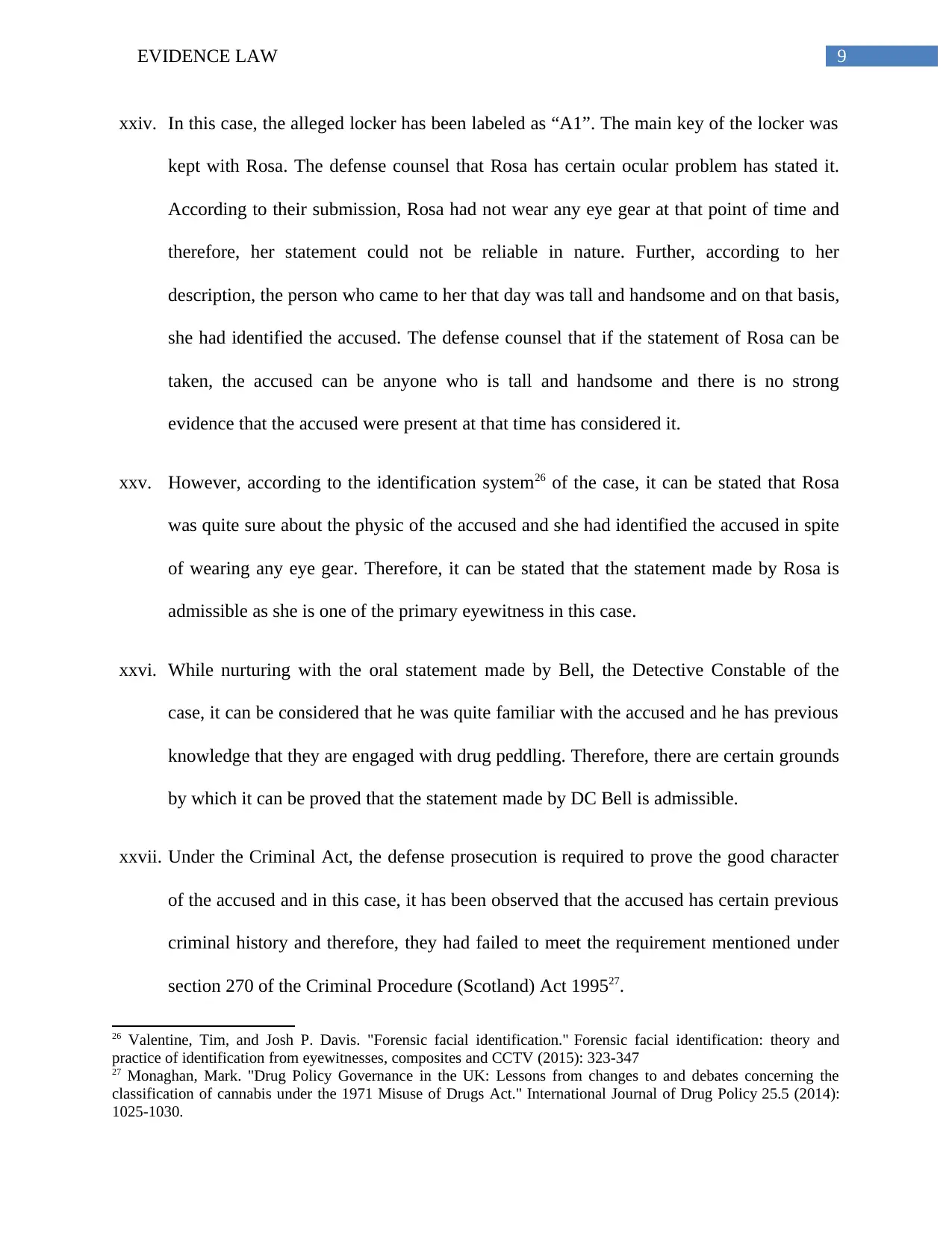
9EVIDENCE LAW
xxiv. In this case, the alleged locker has been labeled as “A1”. The main key of the locker was
kept with Rosa. The defense counsel that Rosa has certain ocular problem has stated it.
According to their submission, Rosa had not wear any eye gear at that point of time and
therefore, her statement could not be reliable in nature. Further, according to her
description, the person who came to her that day was tall and handsome and on that basis,
she had identified the accused. The defense counsel that if the statement of Rosa can be
taken, the accused can be anyone who is tall and handsome and there is no strong
evidence that the accused were present at that time has considered it.
xxv. However, according to the identification system26 of the case, it can be stated that Rosa
was quite sure about the physic of the accused and she had identified the accused in spite
of wearing any eye gear. Therefore, it can be stated that the statement made by Rosa is
admissible as she is one of the primary eyewitness in this case.
xxvi. While nurturing with the oral statement made by Bell, the Detective Constable of the
case, it can be considered that he was quite familiar with the accused and he has previous
knowledge that they are engaged with drug peddling. Therefore, there are certain grounds
by which it can be proved that the statement made by DC Bell is admissible.
xxvii. Under the Criminal Act, the defense prosecution is required to prove the good character
of the accused and in this case, it has been observed that the accused has certain previous
criminal history and therefore, they had failed to meet the requirement mentioned under
section 270 of the Criminal Procedure (Scotland) Act 199527.
26 Valentine, Tim, and Josh P. Davis. "Forensic facial identification." Forensic facial identification: theory and
practice of identification from eyewitnesses, composites and CCTV (2015): 323-347
27 Monaghan, Mark. "Drug Policy Governance in the UK: Lessons from changes to and debates concerning the
classification of cannabis under the 1971 Misuse of Drugs Act." International Journal of Drug Policy 25.5 (2014):
1025-1030.
xxiv. In this case, the alleged locker has been labeled as “A1”. The main key of the locker was
kept with Rosa. The defense counsel that Rosa has certain ocular problem has stated it.
According to their submission, Rosa had not wear any eye gear at that point of time and
therefore, her statement could not be reliable in nature. Further, according to her
description, the person who came to her that day was tall and handsome and on that basis,
she had identified the accused. The defense counsel that if the statement of Rosa can be
taken, the accused can be anyone who is tall and handsome and there is no strong
evidence that the accused were present at that time has considered it.
xxv. However, according to the identification system26 of the case, it can be stated that Rosa
was quite sure about the physic of the accused and she had identified the accused in spite
of wearing any eye gear. Therefore, it can be stated that the statement made by Rosa is
admissible as she is one of the primary eyewitness in this case.
xxvi. While nurturing with the oral statement made by Bell, the Detective Constable of the
case, it can be considered that he was quite familiar with the accused and he has previous
knowledge that they are engaged with drug peddling. Therefore, there are certain grounds
by which it can be proved that the statement made by DC Bell is admissible.
xxvii. Under the Criminal Act, the defense prosecution is required to prove the good character
of the accused and in this case, it has been observed that the accused has certain previous
criminal history and therefore, they had failed to meet the requirement mentioned under
section 270 of the Criminal Procedure (Scotland) Act 199527.
26 Valentine, Tim, and Josh P. Davis. "Forensic facial identification." Forensic facial identification: theory and
practice of identification from eyewitnesses, composites and CCTV (2015): 323-347
27 Monaghan, Mark. "Drug Policy Governance in the UK: Lessons from changes to and debates concerning the
classification of cannabis under the 1971 Misuse of Drugs Act." International Journal of Drug Policy 25.5 (2014):
1025-1030.
Paraphrase This Document
Need a fresh take? Get an instant paraphrase of this document with our AI Paraphraser
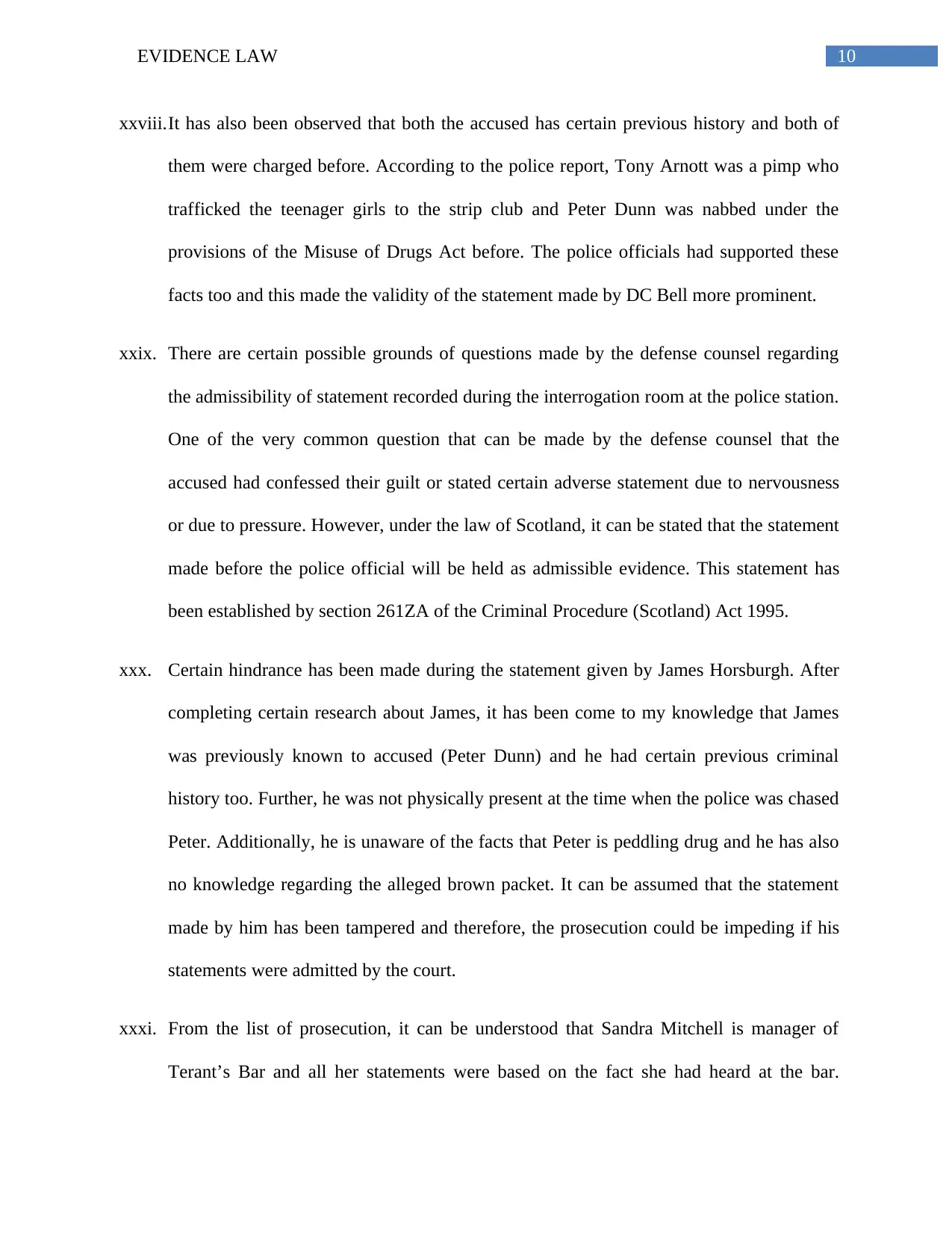
10EVIDENCE LAW
xxviii.It has also been observed that both the accused has certain previous history and both of
them were charged before. According to the police report, Tony Arnott was a pimp who
trafficked the teenager girls to the strip club and Peter Dunn was nabbed under the
provisions of the Misuse of Drugs Act before. The police officials had supported these
facts too and this made the validity of the statement made by DC Bell more prominent.
xxix. There are certain possible grounds of questions made by the defense counsel regarding
the admissibility of statement recorded during the interrogation room at the police station.
One of the very common question that can be made by the defense counsel that the
accused had confessed their guilt or stated certain adverse statement due to nervousness
or due to pressure. However, under the law of Scotland, it can be stated that the statement
made before the police official will be held as admissible evidence. This statement has
been established by section 261ZA of the Criminal Procedure (Scotland) Act 1995.
xxx. Certain hindrance has been made during the statement given by James Horsburgh. After
completing certain research about James, it has been come to my knowledge that James
was previously known to accused (Peter Dunn) and he had certain previous criminal
history too. Further, he was not physically present at the time when the police was chased
Peter. Additionally, he is unaware of the facts that Peter is peddling drug and he has also
no knowledge regarding the alleged brown packet. It can be assumed that the statement
made by him has been tampered and therefore, the prosecution could be impeding if his
statements were admitted by the court.
xxxi. From the list of prosecution, it can be understood that Sandra Mitchell is manager of
Terant’s Bar and all her statements were based on the fact she had heard at the bar.
xxviii.It has also been observed that both the accused has certain previous history and both of
them were charged before. According to the police report, Tony Arnott was a pimp who
trafficked the teenager girls to the strip club and Peter Dunn was nabbed under the
provisions of the Misuse of Drugs Act before. The police officials had supported these
facts too and this made the validity of the statement made by DC Bell more prominent.
xxix. There are certain possible grounds of questions made by the defense counsel regarding
the admissibility of statement recorded during the interrogation room at the police station.
One of the very common question that can be made by the defense counsel that the
accused had confessed their guilt or stated certain adverse statement due to nervousness
or due to pressure. However, under the law of Scotland, it can be stated that the statement
made before the police official will be held as admissible evidence. This statement has
been established by section 261ZA of the Criminal Procedure (Scotland) Act 1995.
xxx. Certain hindrance has been made during the statement given by James Horsburgh. After
completing certain research about James, it has been come to my knowledge that James
was previously known to accused (Peter Dunn) and he had certain previous criminal
history too. Further, he was not physically present at the time when the police was chased
Peter. Additionally, he is unaware of the facts that Peter is peddling drug and he has also
no knowledge regarding the alleged brown packet. It can be assumed that the statement
made by him has been tampered and therefore, the prosecution could be impeding if his
statements were admitted by the court.
xxxi. From the list of prosecution, it can be understood that Sandra Mitchell is manager of
Terant’s Bar and all her statements were based on the fact she had heard at the bar.
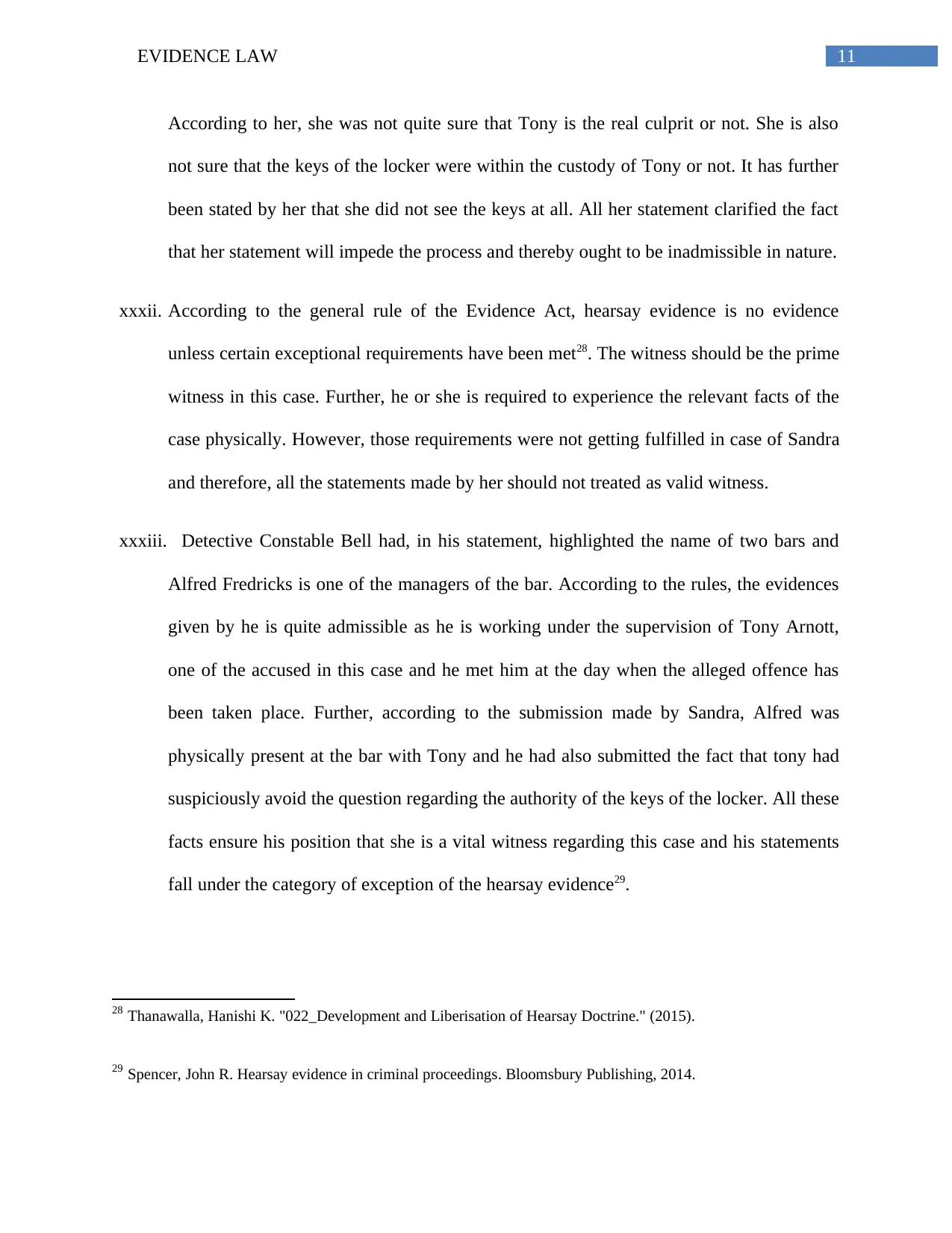
11EVIDENCE LAW
According to her, she was not quite sure that Tony is the real culprit or not. She is also
not sure that the keys of the locker were within the custody of Tony or not. It has further
been stated by her that she did not see the keys at all. All her statement clarified the fact
that her statement will impede the process and thereby ought to be inadmissible in nature.
xxxii. According to the general rule of the Evidence Act, hearsay evidence is no evidence
unless certain exceptional requirements have been met28. The witness should be the prime
witness in this case. Further, he or she is required to experience the relevant facts of the
case physically. However, those requirements were not getting fulfilled in case of Sandra
and therefore, all the statements made by her should not treated as valid witness.
xxxiii. Detective Constable Bell had, in his statement, highlighted the name of two bars and
Alfred Fredricks is one of the managers of the bar. According to the rules, the evidences
given by he is quite admissible as he is working under the supervision of Tony Arnott,
one of the accused in this case and he met him at the day when the alleged offence has
been taken place. Further, according to the submission made by Sandra, Alfred was
physically present at the bar with Tony and he had also submitted the fact that tony had
suspiciously avoid the question regarding the authority of the keys of the locker. All these
facts ensure his position that she is a vital witness regarding this case and his statements
fall under the category of exception of the hearsay evidence29.
28 Thanawalla, Hanishi K. "022_Development and Liberisation of Hearsay Doctrine." (2015).
29 Spencer, John R. Hearsay evidence in criminal proceedings. Bloomsbury Publishing, 2014.
According to her, she was not quite sure that Tony is the real culprit or not. She is also
not sure that the keys of the locker were within the custody of Tony or not. It has further
been stated by her that she did not see the keys at all. All her statement clarified the fact
that her statement will impede the process and thereby ought to be inadmissible in nature.
xxxii. According to the general rule of the Evidence Act, hearsay evidence is no evidence
unless certain exceptional requirements have been met28. The witness should be the prime
witness in this case. Further, he or she is required to experience the relevant facts of the
case physically. However, those requirements were not getting fulfilled in case of Sandra
and therefore, all the statements made by her should not treated as valid witness.
xxxiii. Detective Constable Bell had, in his statement, highlighted the name of two bars and
Alfred Fredricks is one of the managers of the bar. According to the rules, the evidences
given by he is quite admissible as he is working under the supervision of Tony Arnott,
one of the accused in this case and he met him at the day when the alleged offence has
been taken place. Further, according to the submission made by Sandra, Alfred was
physically present at the bar with Tony and he had also submitted the fact that tony had
suspiciously avoid the question regarding the authority of the keys of the locker. All these
facts ensure his position that she is a vital witness regarding this case and his statements
fall under the category of exception of the hearsay evidence29.
28 Thanawalla, Hanishi K. "022_Development and Liberisation of Hearsay Doctrine." (2015).
29 Spencer, John R. Hearsay evidence in criminal proceedings. Bloomsbury Publishing, 2014.
⊘ This is a preview!⊘
Do you want full access?
Subscribe today to unlock all pages.

Trusted by 1+ million students worldwide
1 out of 19
Your All-in-One AI-Powered Toolkit for Academic Success.
+13062052269
info@desklib.com
Available 24*7 on WhatsApp / Email
![[object Object]](/_next/static/media/star-bottom.7253800d.svg)
Unlock your academic potential
Copyright © 2020–2025 A2Z Services. All Rights Reserved. Developed and managed by ZUCOL.